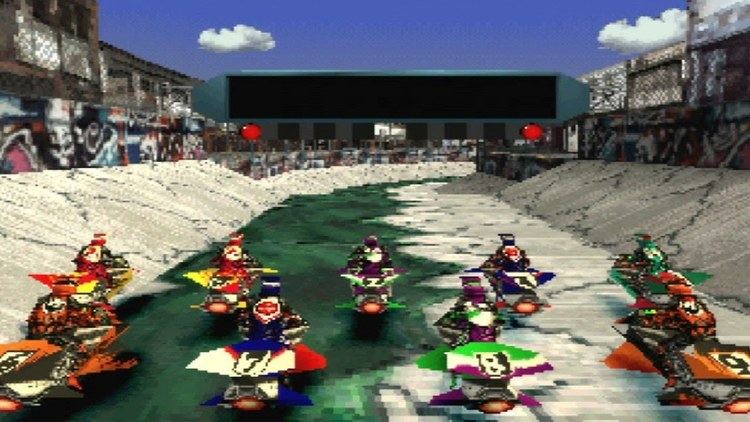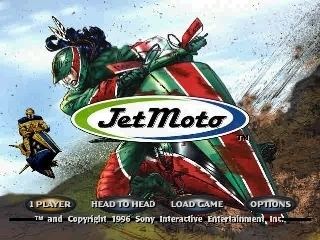Initial release date 31 October 1996 Series Jet Moto | Genre Racing video game | |
 | ||
Composer(s) Big Idea Music Productions Release date(s) PlayStationNA: October 31, 1996EU: February 1997WindowsNA: November 30, 1997PlayStation NetworkJP: June 28, 2007NA: February 4, 2007 (PSP)NA: May 3, 2007 (PS3)PAL: December 4, 2008 Mode(s) Single-player, multiplayer Publishers Sony Interactive Entertainment, 989 Studios Similar SingleTrac games, Racing video games | ||
Jet Moto (known as Jet Rider in Europe) is a 1996 racing video game developed by SingleTrac and published by Sony Computer Entertainment for the PlayStation video game console and PC. The PlayStation version was released in North America on October 31, 1996, in Europe in February 1997, and Japan on August 7, 1997. The PC version was released on November 30, 1997. On February 4, 2007 Jet Moto was made available for the PlayStation Portable and PlayStation 3 via the PlayStation Network. Developers chose fictional hovering bikes instead of wheeled motorcycles initially to resolve performance concerns. Other performance concerns led the team to develop two different physics systems—one for the player, and one for the 19 computer racers.
Contents

Gameplay in Jet Moto revolves around the use of hoverbikes to traverse a race course, similar to modern day motorcross, but with the added ability to traverse water. Reviews for the game were mixed, with the PC version holding 75% and the PlayStation version 78.9% at gaming aggregator GameRankings. Reviewers felt the game had solid gameplay, but criticized its high difficulty. Jet Moto's popularity would earn it a spot in the PlayStation Greatest Hits in August 1998, and it went on to gain two additional sequels, Jet Moto 2 and Jet Moto 3.

Gameplay

Jet Moto differs from that of a traditional racing game with cars or motorcycles. Players are introduced to the fictional sport of Jet Moto. The bikes, known as jet motos, are hovercraft which can traverse both land and water. The bikes race in groups of twenty in the game's equivalent of motorcross. Characters are split into teams, and bikes are adorned with logos of products such as Mountain Dew, Butterfinger and K2 Sports similar to real-life sponsored racing.

In Jet Moto players control hoverbikes in a fictional motor sport. Players race three laps on a given course and earn series points based on their placement at the end of the race. Players can choose to race a single race, a season of races, or a custom season. Players can also unlock additional tracks and a stunt mode by doing well in season competitions.
Courses range from beaches with debris-littered water to swamps and ice-covered mountains. The game has its variant of the traditional race track, but also introduces a new course type known as a Suicide course. Instead of being a continuous loop, these tracks have checkpoints at either end of the course, and the starting grid in the center. Riders race to one end, then turn around to head for the other checkpoint, repeating the process until all laps are complete. This provides a new gameplay dynamic as often the player must navigate oncoming traffic.
Jet Moto also utilizes a magnetic grappling system. Pressing the assigned button near a red energy pole creates a magnetic attraction between the player's bike and the pole, allowing riders to traverse tight turns and clear large chasms otherwise be impossible. In addition to the grapple system players are given four boosts per lap, which provide a temporary burst of speed. The PlayStation version of the game allows for two player splitscreen multiplayer, however no AI racers are present, which limits the competitors to two. A cheat code would allow two human players to race with the entire field. The PC version allows for fourteen players over an IPX network, Internet TCP/IP and modem-to-modem connections.
Development
Jet Moto was conceived as a "science fiction motorcross." The developers chose to create jet motos instead of wheeled motorcycles due to concerns over polygon limitations. Travis Hilton, one of the programmers for the game designed Jet Moto's physics engine. Due to hardware limitations of the PlayStation, only the player used this physics system. Programmer Jay Barnson was tasked with developing a simpler physics system to handle the nineteen AI riders. During development a set of courses set in a stadium were dropped as the developers felt it did not fit the theme of the game.
Developers originally intended for players to be permanently out of a race when falling far off a track, however they came to realize that it was not fun for players "to be forced to go slow or suffer an instant defeat." An attempt was made to give three "strikes" to a rider. Once the rider fell for the third time they were out of the race. However once implemented developers noticed that the number of racers remaining at the end of the race was too random to be deemed any fun. In the end the decision was made to simply respawn the character on the track. The PC version was ported in large part by John Olsen, who worked on the port as his first task at SingleTrac. The PC version also features 3Dfx hardware acceleration, which allows for higher resolution gameplay and visual enhancements such as reflective water. Axiom Design created the user interface shell for the game, which has a comic book-inspired feel. The music for Jet Moto was produced by Big Idea Music Productions.
Reception
Jet Moto received varied reviews among critics, with the PC version averaging 75% and the PlayStation version averaging 78.9% at gaming aggregator GameRankings. Due to the game's popularity it was added Sony's budget line known as PlayStation Greatest Hits in August 1998.
Several reviewers praised the overall gameplay of Jet Moto. Chris Roper of IGN called it one of the best racing games available for the PlayStation. In its PlayStation 3 Retro Roundup, IGN pointed out the game's direct competitors at the time, Wave Race 64 and the Wipeout series, then stated Jet Moto was "still a pretty fun experience more than 10 years after its original release." Electric Playground's Victor Lucas praised the design of the jet moto bikes, stating the design was imaginative and vibrant. Several reviewers also praised the soundtrack to the game. Mark Cooke of Game Revolution called the Dick Dale-esque music which seemed reminiscent of spy films such as the James Bond theme. The surf guitar was a strong point for Victor Lucas of Electric Playground, who cited it as one of the best video game soundtracks of 1996. GameSpot reviewer Shane Mooney also praised the energy of the soundtrack.
Reviewers felt the game had an extremely high degree of difficulty. GamePro's reviewer cited overly skilled AI racers and poor collision detections as reasons to avoid Jet Moto. Several reviewers cited the games graphics as a down point in the game, although GameSpot's review of the PC port praised the 3Dfx support. Electric Playground also compared it to Wave Race 64, but called the game "light on the great graphics".
Legacy
Jet Moto's popularity would spawn two additional sequels, Jet Moto 2, also developed by SingleTrac, and Jet Moto 3, developed by Pacific Coast Power & Light. Two other titles were cancelled during their development. Pacific Coast Power & Light was also developing Jet Moto 2124 for the PlayStation, set over a century after the first three games, however the game was cancelled when Jet Moto 3 showed poor sales. Jet Moto: SOLAR, developed by RedZone Interactive, was also cancelled. SOLAR would have been the first title in the series to appear on the PlayStation 2.
Present-day wishlists for video game sequels have often included Jet Moto. 1UP.com listed a fourth Jet Moto in their "Sequels We Want, and the Formulas They Need" feature, stating that Jet Moto "symbolized everything that made the original PlayStation cooler than anything else at the time". IGN felt similarly, listing Jet Moto in their "Dirty Dozen: Revival of the Fittest" feature, calling the game "a novel racer with enough staying power to make it an instant hit".
